Abstract
Data from a survey conducted in 1981 on a national sample of 5508 births in France were used to analyse the role of a history of previous adverse pregnancy outcome (spontaneous abortion, perinatal death or adverse fetal condition) in the selection mechanisms of women with regard to occupational activity, and the impact on the relation between work and preterm delivery. The study, carried out separately in each parity group, showed that occupational activity was associated with a more favourable outcome for women of parity one: the preterm delivery rate was significantly higher among women who had never worked than among those who continued working during pregnancy. However, the hypothesis of a "healthy worker effect" linked to a history of adverse obstetric outcome was not confirmed in this study. A selection effect of women from a history of spontaneous abortions was observed, but these were not linked to preterm delivery. Among multiparous women, a history of perinatal death or adverse fetal condition did not seem to modify women's behaviour towards their work. Selection mechanisms of women towards occupational activity according to sociodemographic factors were also analysed and showed that the higher percentage of younger women among those who had never worked explained the higher rate of preterm delivery in that group.
Full text
PDF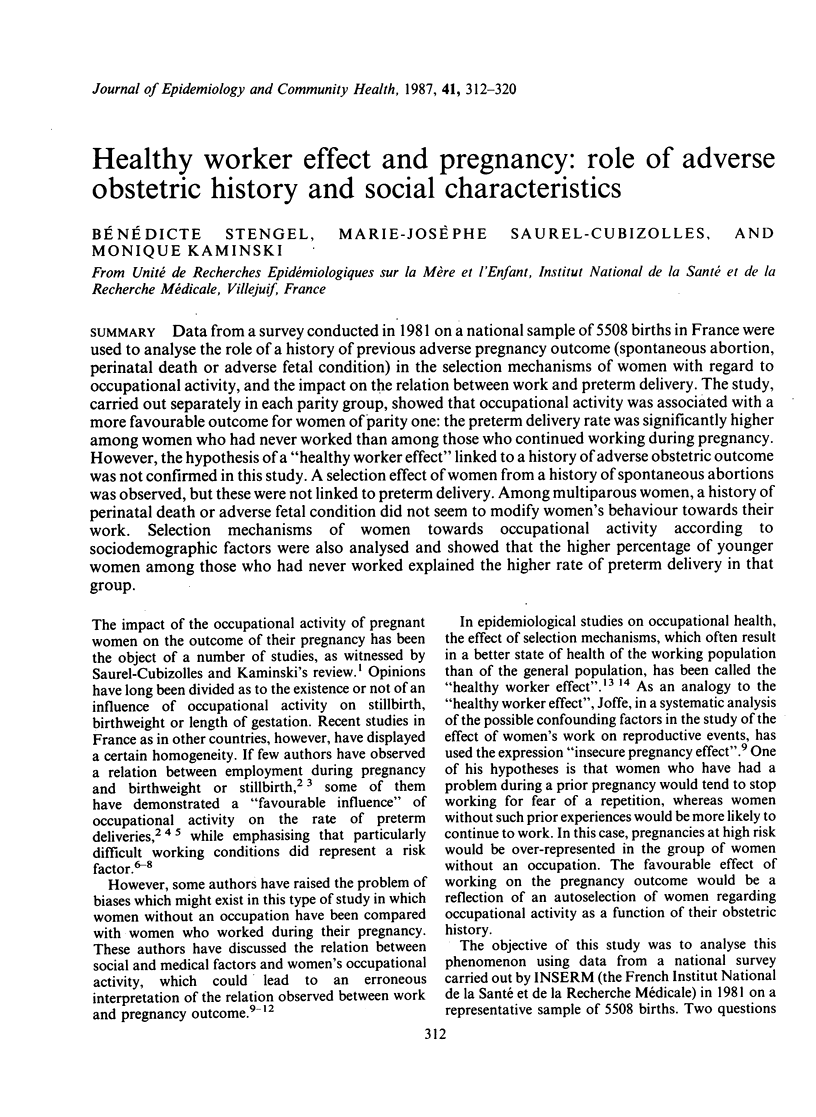
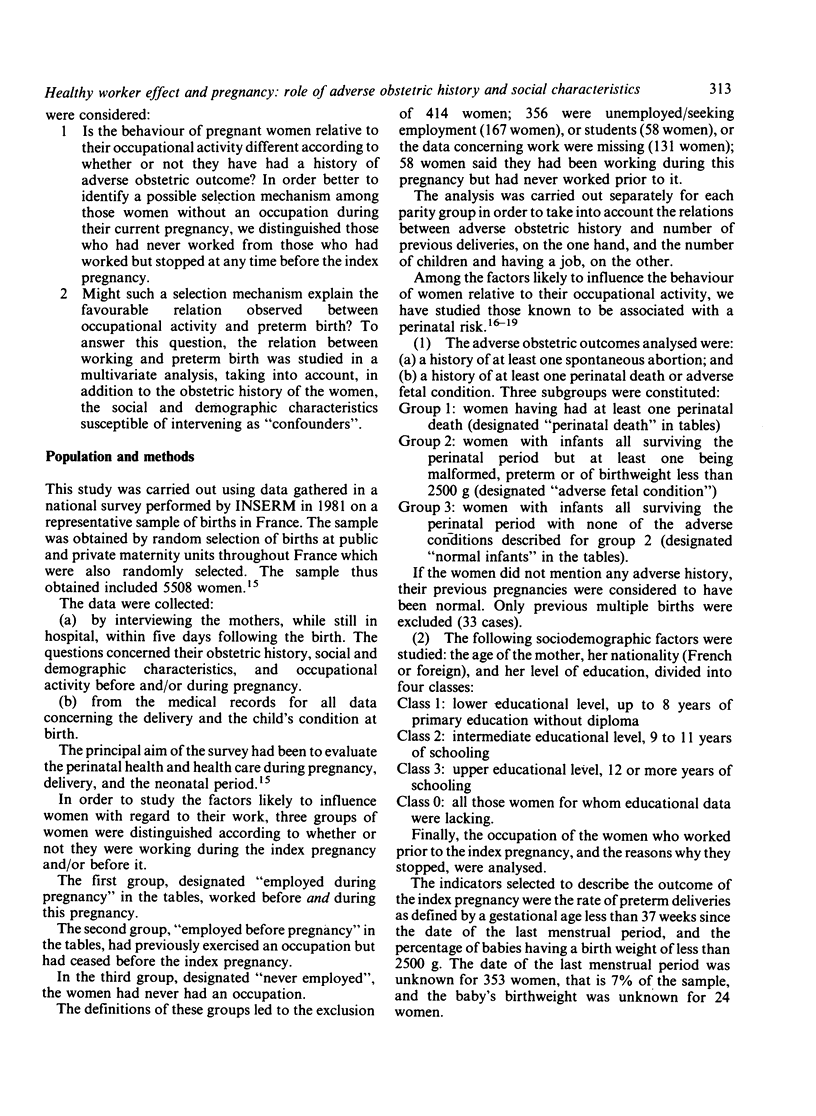
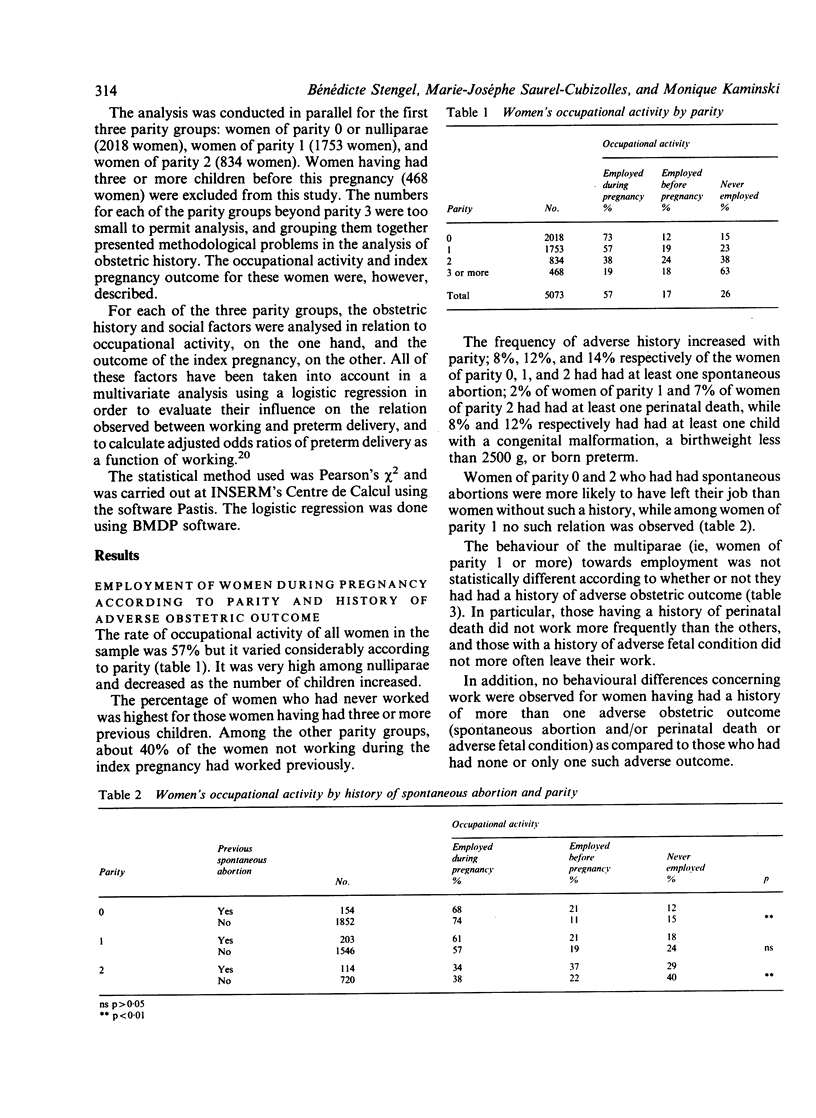
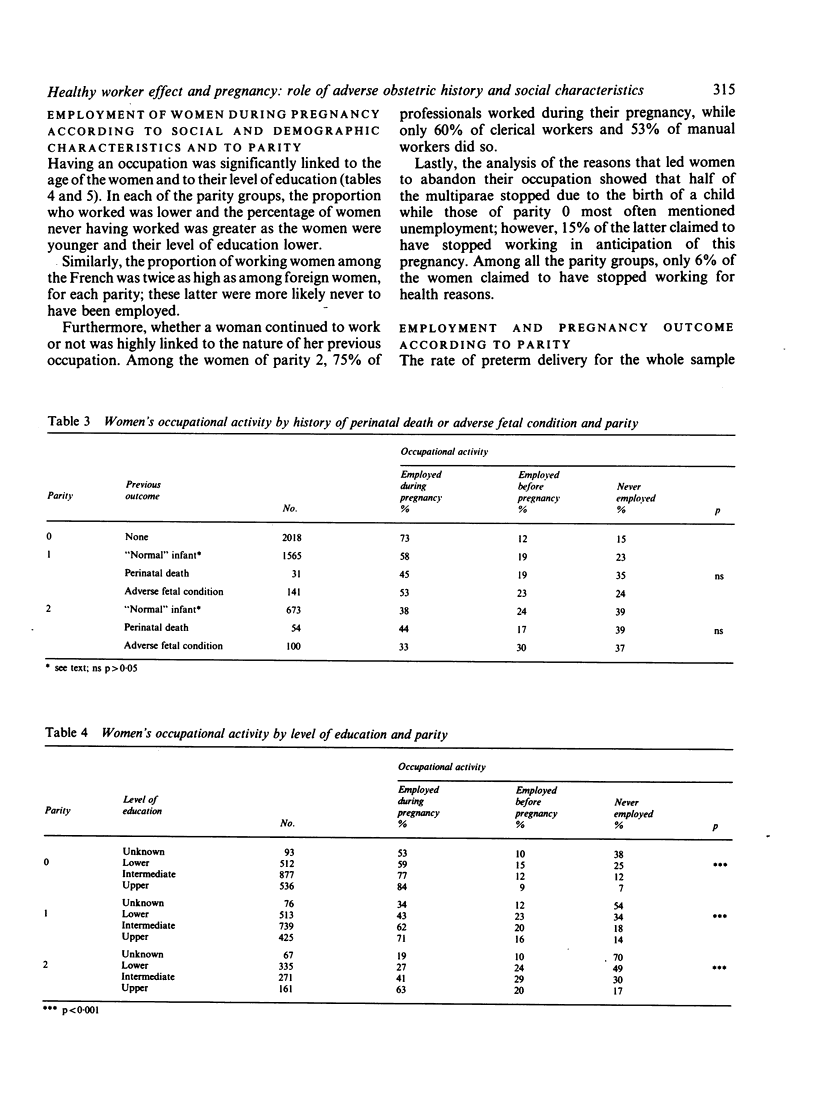
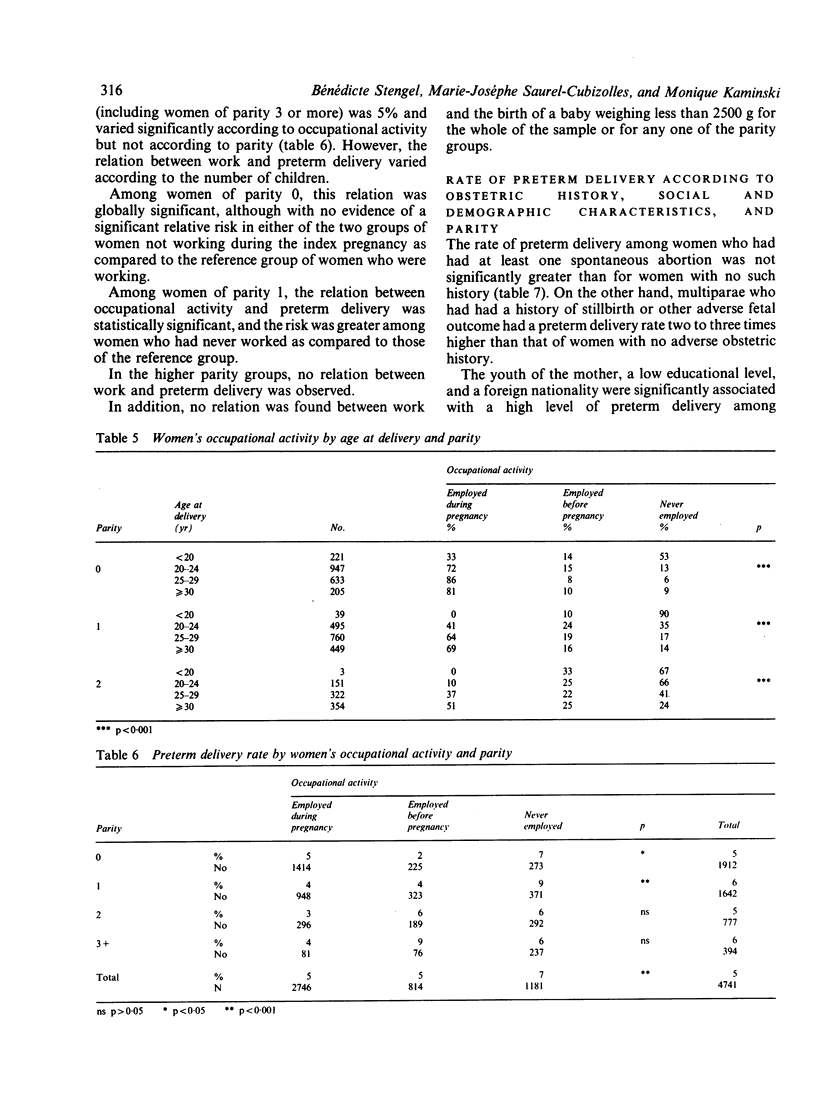
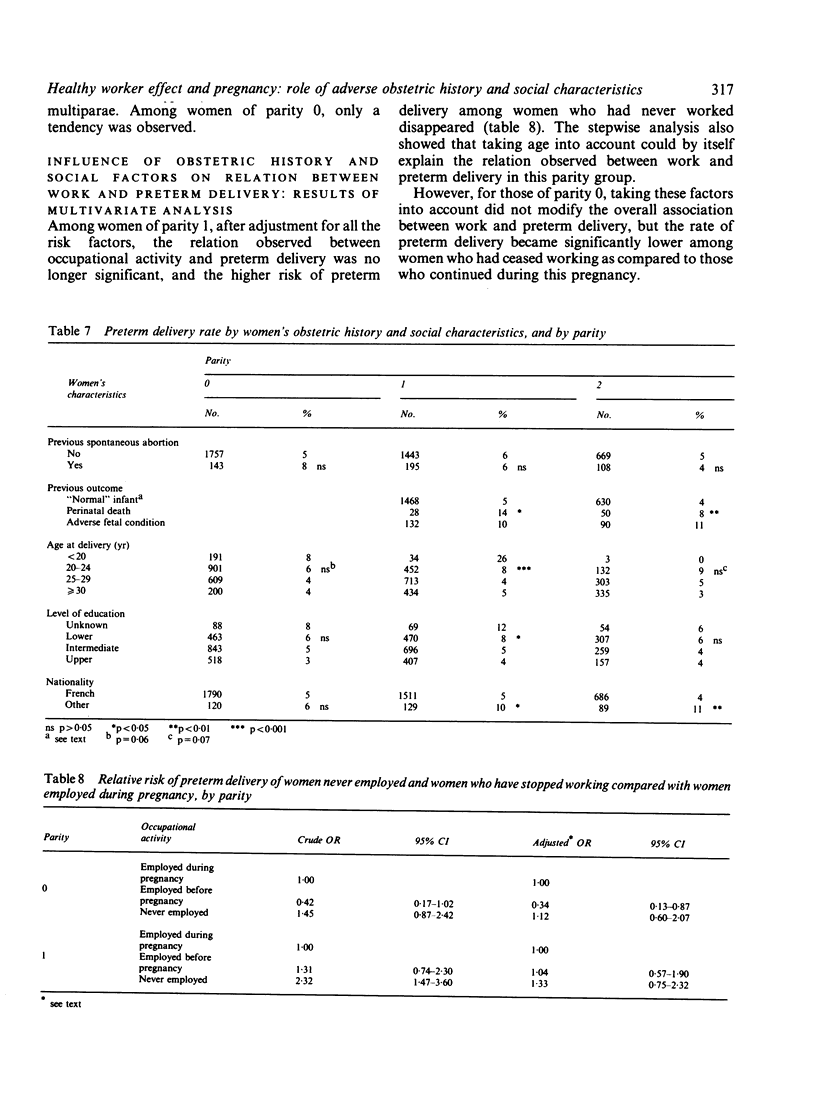
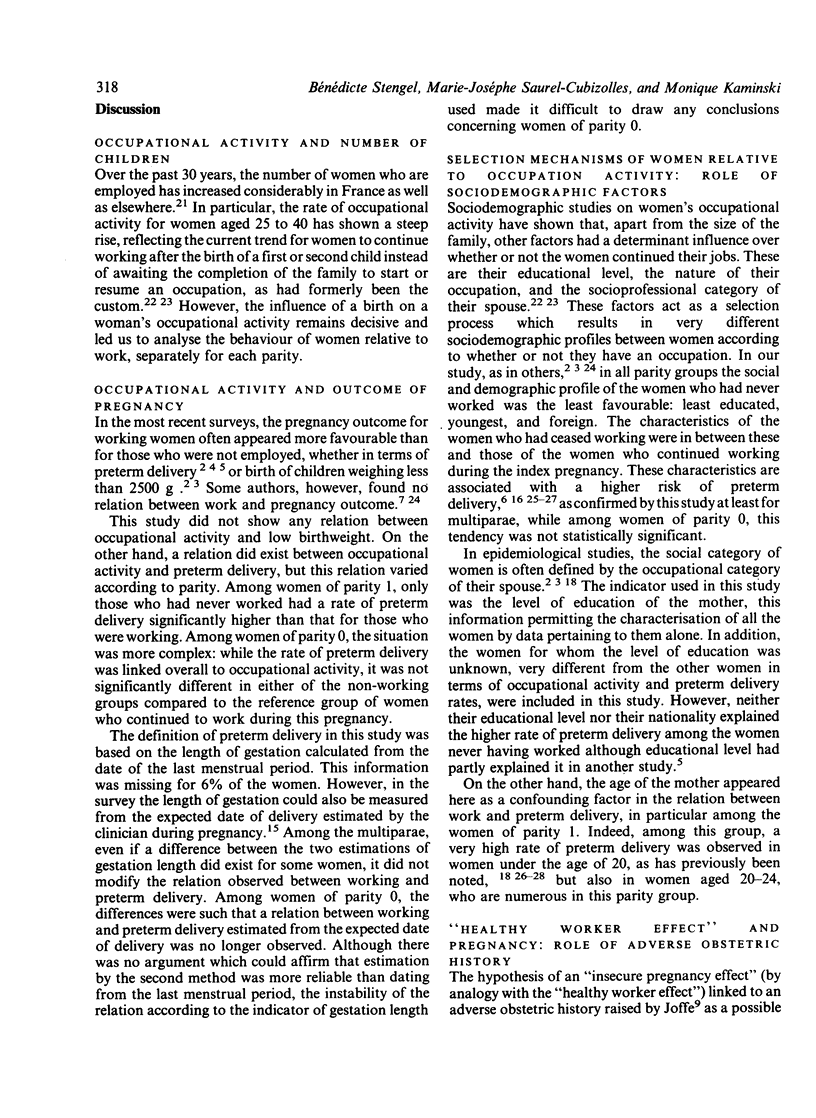
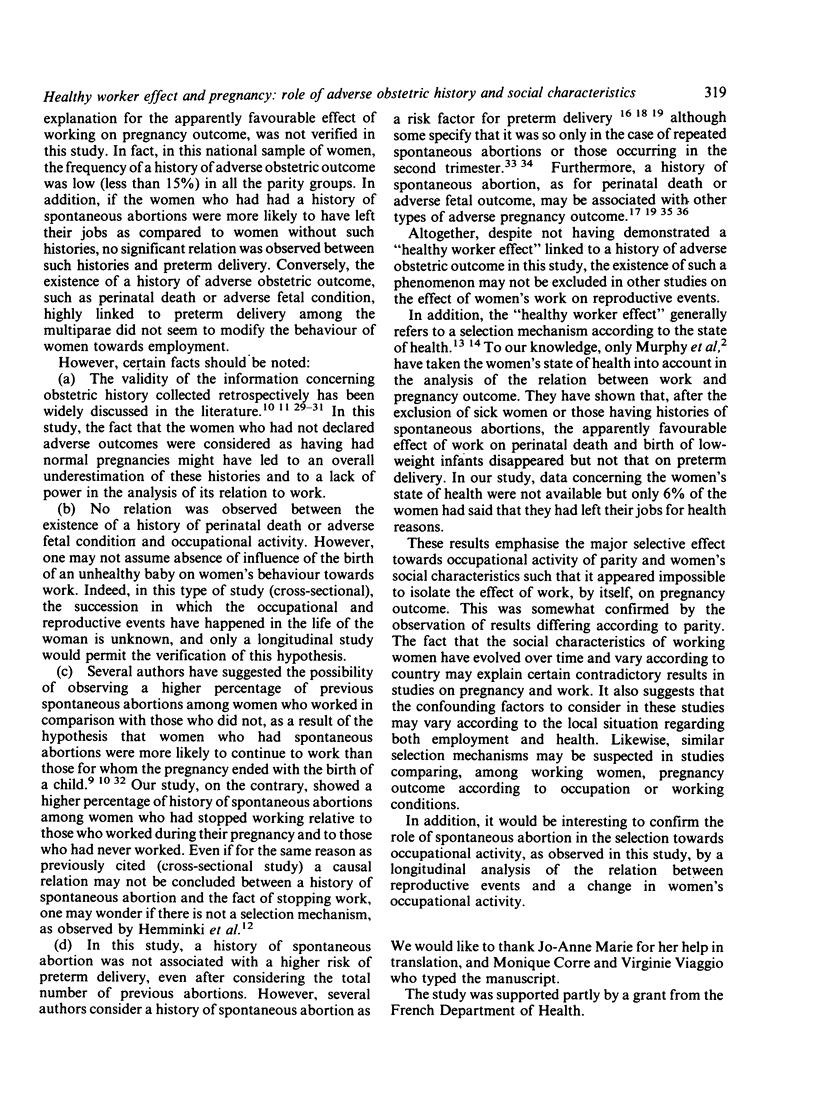
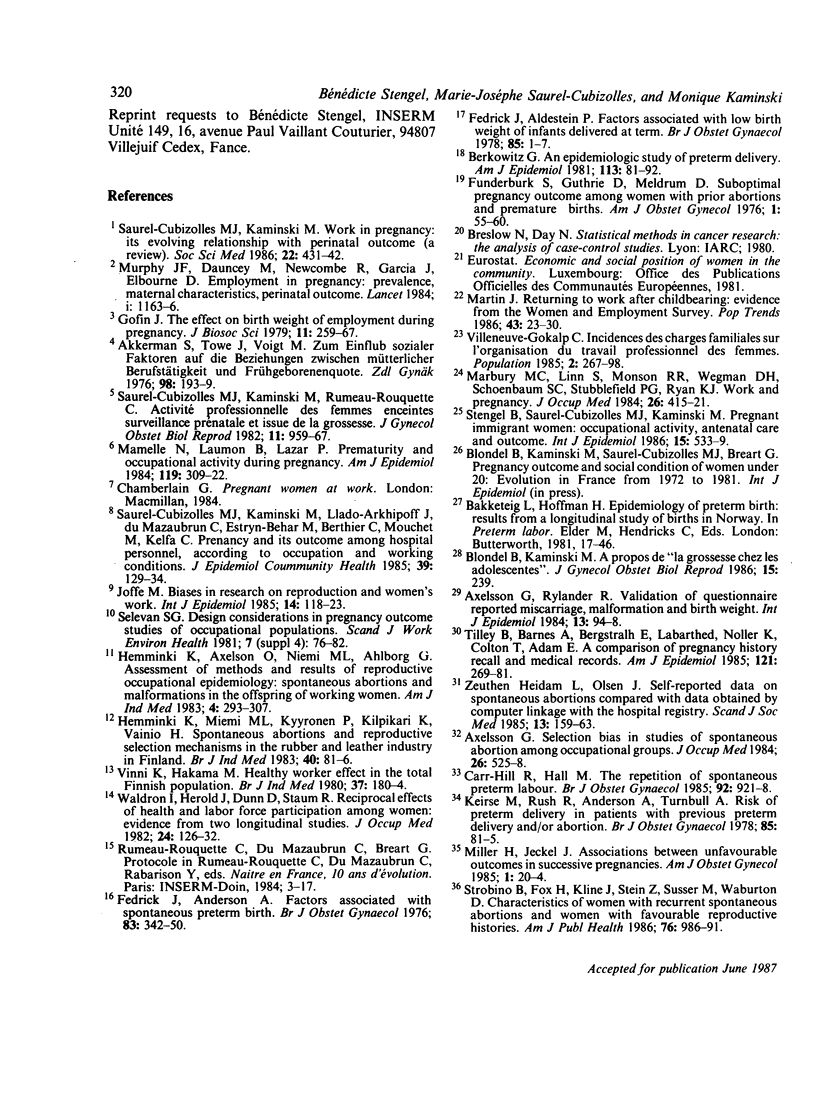
Selected References
These references are in PubMed. This may not be the complete list of references from this article.
- Akkermann S., Töwe J., Voigt M. Zum Einfluss sozialer Faktoren auf die Beziehungen zwischen mütterlicher Berufsätigkeit und Frühgeborenenquote. Zentralbl Gynakol. 1976;98(4):193–199. [PubMed] [Google Scholar]
- Axelsson G., Rylander R. Validation of questionnaire reported miscarriage, malformation and birth weight. Int J Epidemiol. 1984 Mar;13(1):94–98. doi: 10.1093/ije/13.1.94. [DOI] [PubMed] [Google Scholar]
- Axelsson G. Selection bias in studies of spontaneous abortion among occupational groups. J Occup Med. 1984 Jul;26(7):525–528. [PubMed] [Google Scholar]
- Berkowitz G. S. An epidemiologic study of preterm delivery. Am J Epidemiol. 1981 Jan;113(1):81–92. doi: 10.1093/oxfordjournals.aje.a113068. [DOI] [PubMed] [Google Scholar]
- Blondel B., Kaminski M. A propos de "la grossesse chez les adolescentes.". J Gynecol Obstet Biol Reprod (Paris) 1986;15(2):239–239. [PubMed] [Google Scholar]
- Carr-Hill R. A., Hall M. H. The repetition of spontaneous preterm labour. Br J Obstet Gynaecol. 1985 Sep;92(9):921–928. doi: 10.1111/j.1471-0528.1985.tb03071.x. [DOI] [PubMed] [Google Scholar]
- Fedrick J., Adelstein P. Factors associated with low birth weight of infants delivered at term. Br J Obstet Gynaecol. 1978 Jan;85(1):1–7. doi: 10.1111/j.1471-0528.1978.tb15816.x. [DOI] [PubMed] [Google Scholar]
- Fedrick J., Anderson A. B. Factors associated with spontaneous pre-term birth. Br J Obstet Gynaecol. 1976 May;83(5):342–350. doi: 10.1111/j.1471-0528.1976.tb00840.x. [DOI] [PubMed] [Google Scholar]
- Funderburk S. J., Guthrie D., Meldrum D. Suboptimal pregnancy outcome among women with prior abortions and premature births. Am J Obstet Gynecol. 1976 Sep 1;126(1):55–60. doi: 10.1016/0002-9378(76)90465-8. [DOI] [PubMed] [Google Scholar]
- Gofin J. The effect on birth weight of employment during pregnancy. J Biosoc Sci. 1979 Jul;11(3):259–267. doi: 10.1017/s0021932000012335. [DOI] [PubMed] [Google Scholar]
- Heidam L. Z., Olsen J. Self-reported data on spontaneous abortions compared with data obtained by computer linkage with the hospital registry. Scand J Soc Med. 1985;13(4):159–163. doi: 10.1177/140349488501300406. [DOI] [PubMed] [Google Scholar]
- Hemminki K., Axelson O., Niemi M. L., Ahlborg G. Assessment of methods and results of reproductive occupational epidemiology: spontaneous abortions and malformations in the offspring of working women. Am J Ind Med. 1983;4(1-2):293–307. [PubMed] [Google Scholar]
- Hemminki K., Niemi M. L., Kyyrönen P., Kilpikari I., Vainio H. Spontaneous abortions and reproductive selection mechanisms in the rubber and leather industry in Finland. Br J Ind Med. 1983 Feb;40(1):81–86. doi: 10.1136/oem.40.1.81. [DOI] [PMC free article] [PubMed] [Google Scholar]
- Joffe M. Biases in research on reproduction and women's work. Int J Epidemiol. 1985 Mar;14(1):118–123. doi: 10.1093/ije/14.1.118. [DOI] [PubMed] [Google Scholar]
- Keirse M. J., Rush R. W., Anderson A. B., Turnbull A. C. Risk of pre-term delivery in patients with previous pre-term delivery and/or abortion. Br J Obstet Gynaecol. 1978 Feb;85(2):81–85. doi: 10.1111/j.1471-0528.1978.tb10457.x. [DOI] [PubMed] [Google Scholar]
- Mamelle N., Laumon B., Lazar P. Prematurity and occupational activity during pregnancy. Am J Epidemiol. 1984 Mar;119(3):309–322. doi: 10.1093/oxfordjournals.aje.a113750. [DOI] [PubMed] [Google Scholar]
- Marbury M. C., Linn S., Monson R. R., Wegman D. H., Schoenbaum S. C., Stubblefield P. G., Ryan K. J. Work and pregnancy. J Occup Med. 1984 Jun;26(6):415–421. doi: 10.1097/00043764-198406000-00013. [DOI] [PubMed] [Google Scholar]
- Murphy J. F., Dauncey M., Newcombe R., Garcia J., Elbourne D. Employment in pregnancy: prevalence, maternal characteristics, perinatal outcome. Lancet. 1984 May 26;1(8387):1163–1166. doi: 10.1016/s0140-6736(84)91404-1. [DOI] [PubMed] [Google Scholar]
- Saurel-Cubizolles M. J., Kaminski M., Llado-Arkhipoff J., Du Mazaubrun C., Estryn-Behar M., Berthier C., Mouchet M., Kelfa C. Pregnancy and its outcome among hospital personnel according to occupation and working conditions. J Epidemiol Community Health. 1985 Jun;39(2):129–134. doi: 10.1136/jech.39.2.129. [DOI] [PMC free article] [PubMed] [Google Scholar]
- Saurel-Cubizolles M. J., Kaminski M., Rumeau-Rouquette C. Activité professionnelle des femmes enceintes, surveillance prénatale et issue de la grossesse. J Gynecol Obstet Biol Reprod (Paris) 1982;11(8):959–967. [PubMed] [Google Scholar]
- Saurel-Cubizolles M. J., Kaminski M. Work in pregnancy: its evolving relationship with perinatal outcome (a review). Soc Sci Med. 1986;22(4):431–442. doi: 10.1016/0277-9536(86)90048-1. [DOI] [PubMed] [Google Scholar]
- Selevan S. G. Design considerations in pregnancy outcome studies of occupational populations. Scand J Work Environ Health. 1981;7 (Suppl 4):76–82. [PubMed] [Google Scholar]
- Stengel B., Saurel-Cubizolles M. J., Kaminski M. Pregnant immigrant women: occupational activity, antenatal care and outcome. Int J Epidemiol. 1986 Dec;15(4):533–539. doi: 10.1093/ije/15.4.533. [DOI] [PubMed] [Google Scholar]
- Strobino B., Fox H. E., Kline J., Stein Z., Susser M., Warburton D. Characteristics of women with recurrent spontaneous abortions and women with favorable reproductive histories. Am J Public Health. 1986 Aug;76(8):986–991. doi: 10.2105/ajph.76.8.986. [DOI] [PMC free article] [PubMed] [Google Scholar]
- Tilley B. C., Barnes A. B., Bergstralh E., Labarthe D., Noller K. L., Colton T., Adam E. A comparison of pregnancy history recall and medical records. Implications for retrospective studies. Am J Epidemiol. 1985 Feb;121(2):269–281. doi: 10.1093/oxfordjournals.aje.a113997. [DOI] [PubMed] [Google Scholar]
- Vinni K., Hakama M. Healthy worker effect in the total Finnish population. Br J Ind Med. 1980 May;37(2):180–184. doi: 10.1136/oem.37.2.180. [DOI] [PMC free article] [PubMed] [Google Scholar]
- Waldron I., Herold J., Dunn D., Staum R. Reciprocal effects of health and labor force participation among women: evidence from two longitudinal studies. J Occup Med. 1982 Feb;24(2):126–132. [PubMed] [Google Scholar]


